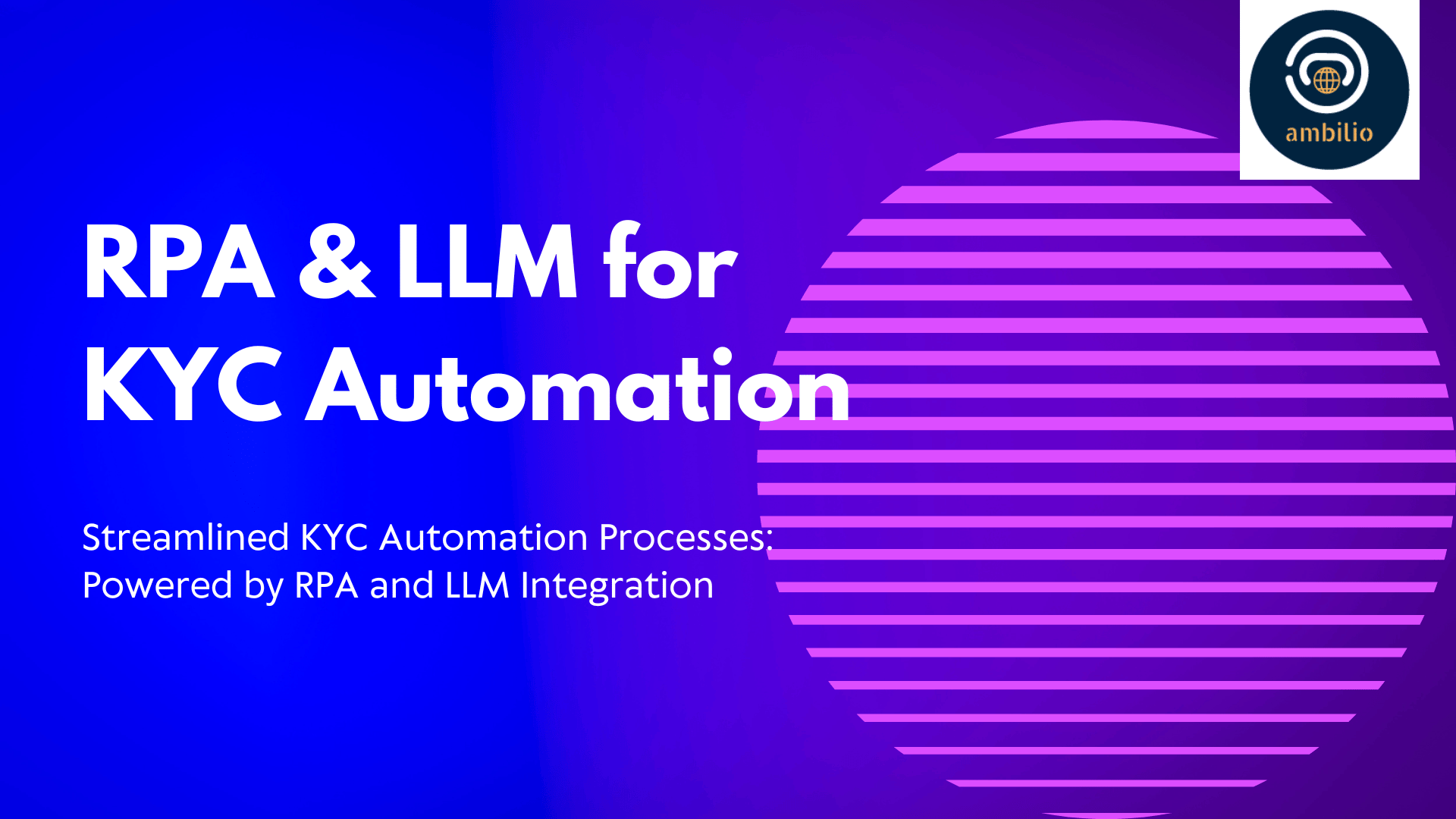Know Your Customer (KYC) processes are crucial for financial institutions to comply with regulations, mitigate risks, and ensure operational integrity. However, traditional KYC processes are often manual, time-consuming, and error-prone. To address these challenges, we propose leveraging an integrated solution of Large Language Models (LLMs) and Robotic Process Automation (RPA) to automate KYC processes in financial services. This approach promises to enhance efficiency, accuracy, and compliance while reducing operational costs. By combining LLMs’ advanced NLP capabilities with RPA’s automation efficiency, financial institutions can streamline KYC operations and focus on delivering enhanced customer experiences.
Understanding LLMs and RPA
Large Language Models (LLMs) are advanced AI systems equipped with Natural Language Processing (NLP) capabilities. They can understand and analyze human language, making them adept at processing various documents and extracting relevant information. On the other hand, Robotic Process Automation (RPA) involves using software bots to automate repetitive tasks traditionally performed by humans, with high accuracy and efficiency.
Key Components of the Integrated Solution
In our proposed integrated solution for automating KYC processes in financial services, the key components include advanced Large Language Models (LLMs) and Robotic Process Automation (RPA). These components work synergistically to streamline KYC operations, starting from document understanding and data extraction to risk assessment and decision-making. LLMs leverage their natural language processing capabilities to interpret various documents and extract relevant information accurately, while RPA automates verification processes, routing tasks, and communication, ensuring efficiency and accuracy throughout the KYC workflow.
- Document Understanding and Data Extraction:
- LLMs can interpret documents like passports, bank statements, and utility bills to extract crucial information such as names, addresses, and identification numbers.
- Optical Character Recognition (OCR) technology enhances LLMs’ ability to capture data from scanned documents accurately.
- Data Verification and Validation:
- LLMs cross-check extracted data against internal databases, public sources, and sanction lists to verify the authenticity of customer-provided information.
- RPA automates the comparison process, ensuring real-time validation and flagging potential discrepancies for further review.
- Risk Assessment and Decision Making:
- LLMs analyze customer data, including transaction history and financial statements, to generate risk scores and identify potential risks associated with a customer.
- RPA facilitates decision-making by routing tasks based on pre-defined rules and risk scores, ensuring efficient handling of KYC processes.
- Customer Communication and Engagement:
- LLMs can interact with customers, providing guidance on KYC processes and addressing queries in a human-like manner.
- RPA streamlines communication by automating responses to common inquiries, enhancing customer experience and satisfaction.
Benefits of RPA and LLMs for KYC Automation
The integrated solution of LLMs and RPA offers numerous benefits to financial institutions. Firstly, it enhances efficiency and speed by automating manual tasks, leading to faster onboarding and reduced processing times. Secondly, the solution improves accuracy and compliance by minimizing human errors and ensuring adherence to KYC regulations. Additionally, financial institutions can achieve significant cost savings and resource optimization by reallocating human resources to more strategic tasks. Moreover, the solution is scalable and adaptable, catering to varying KYC demands and evolving regulatory requirements, thereby driving overall productivity and innovation within the organization.
- Enhanced Efficiency and Speed:
- Automation of data extraction and verification processes leads to faster onboarding and reduced processing times.
- Financial institutions can handle a larger volume of KYC requests efficiently, without compromising accuracy or compliance.
- Improved Accuracy and Compliance:
- LLMs significantly reduce the risk of human errors in data extraction and analysis, ensuring consistent and reliable outcomes.
- Automated validation processes enhance compliance with KYC regulations and reporting requirements, reducing regulatory risks.
- Cost Savings and Resource Optimization:
- By automating repetitive tasks, financial institutions can achieve cost savings associated with manual labor and operational inefficiencies.
- Human resources can be reallocated to more strategic tasks, driving overall productivity and innovation within the organization.
- Scalability and Adaptability:
- The integrated solution can be scaled to accommodate fluctuations in KYC demands, making it suitable for financial institutions of all sizes.
- Continuous improvements and updates to LLMs and RPA technologies ensure adaptability to evolving regulatory requirements and industry standards.
Challenges and Considerations
While the integrated solution presents compelling benefits, it also comes with its set of challenges and considerations. Firstly, data privacy and security are paramount concerns, requiring compliance with regulations and implementation of robust security measures to protect sensitive customer information. Secondly, ensuring explainability and mitigating bias in LLM decisions are essential to maintain transparency and fairness in the automated processes. Lastly, human oversight and training are crucial to integrate human expertise for complex cases and foster a culture of continuous learning and improvement, maximizing the benefits of automation while maintaining the human touch in KYC operations. Addressing these challenges and considerations is imperative to successfully implement and leverage the integrated solution for automating KYC processes in financial services.
- Data Privacy and Security:
- Ensure compliance with data privacy regulations and implement robust security measures to protect sensitive customer information.
- Encrypt data during transmission and storage to prevent unauthorized access or data breaches.
- Explainability and Bias Mitigation:
- Address concerns about transparency and potential bias in LLM decisions by establishing clear explainability frameworks.
- Mitigate bias through diverse training data and regular monitoring of algorithmic outputs.
- Human Oversight and Training:
- Integrate human expertise for complex cases and provide training to employees on working effectively alongside automation tools.
- Foster a culture of continuous learning and improvement to maximize the benefits of the integrated solution.
Final Words
The integration of Large Language Models and Robotic Process Automation offers a compelling solution to automate KYC processes in financial services. By leveraging LLMs’ cognitive capabilities and RPA’s automation efficiency, financial institutions can achieve faster onboarding, reduced costs, improved accuracy, and enhanced compliance. This integrated solution not only streamlines KYC processes but also paves the way for a more efficient and customer-centric approach, ultimately driving growth and success in the financial services industry.



